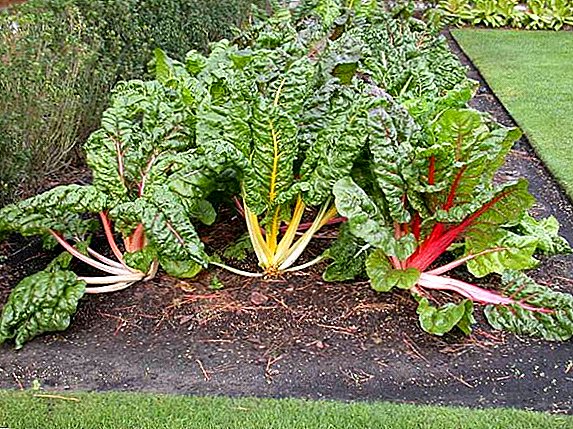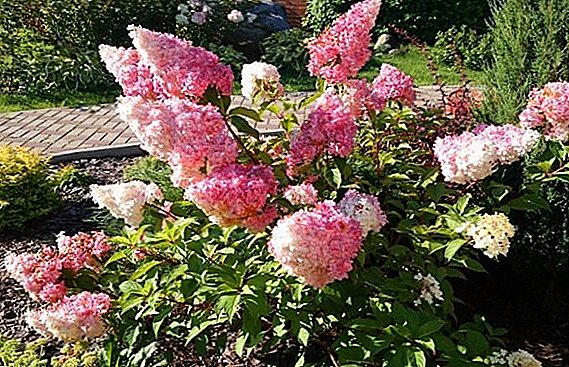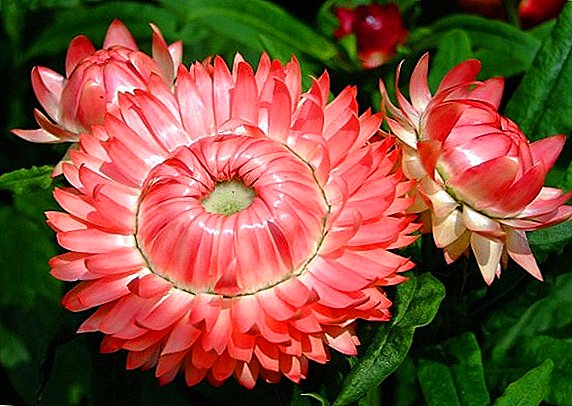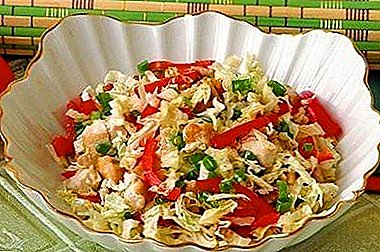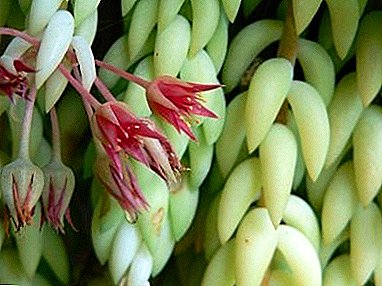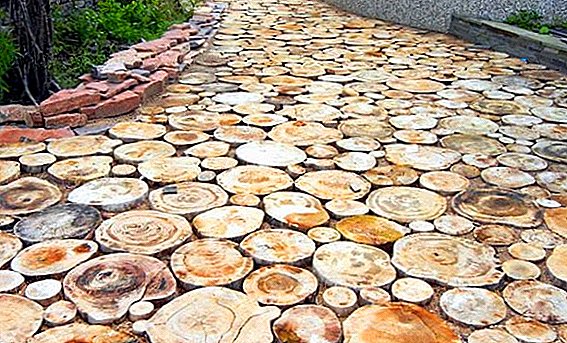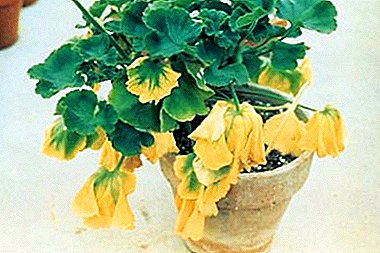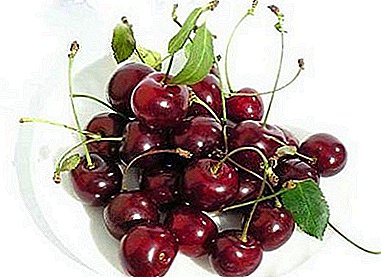
Cherry is rightfully very popular among farmers today. Many people like the original taste of appetizing and healthy sweet and sour red berries.
One such notable cherry species is grade Morozovka.
Cherry Morozovka was liked by gourmets for its excellent taste, and given the feedback from gardeners, it was also a good yield, a full description of the variety and a photo of the fruit are further in the article.
Breeding history and breeding region
 The cherry variety Morozovka (the second name is Morozovskaya) was bred in Russia with an eye on the agrotechnical and weather conditions of the middle zone of the country, which is different mild climate and cold long winters.
The cherry variety Morozovka (the second name is Morozovskaya) was bred in Russia with an eye on the agrotechnical and weather conditions of the middle zone of the country, which is different mild climate and cold long winters.
Based on the requirements of winter hardiness imposed on this fruit species, for several years in the 1980s targeted breeding work was carried out All-Russian Research Institute of Horticulture and Nursery. I.V. Michurin (Michurinsk, Tambov region).
The variety got its name not only because of its resistance to frost, but also by the name of the author - Tamara Morozova, a well-known specialist in the field of stone fruits.
The task was to create a variety that would be adapted to the climatic conditions of central Russia and would be characterized by increased winter hardiness, high yields, exquisite taste properties, small growth and increased resistance to fungal disease coccomycosis.
Frostbite was obtained by crossing cherry varieties Lyubskaya and Vladimirskaya.
Moreover, the seeds of Vladimirskaya before crossing were treated in the germinated phase with a mutagenic chemical ethyleneimine (EI) at a concentration of 0.025%.
Grade Morozovka in 1988 was sent to the State trials.
Such varieties as Turgenevka, Kharitonovskaya, Shokoladnitsa, Shubinka are intended for cultivation in the Middle zone.
Appearance of cherry Morozovka
Cherry Morozovka has the following characteristics:
Tree
 Differs in low or medium height, in most cases plant height does not exceed 2.5 meters.
Differs in low or medium height, in most cases plant height does not exceed 2.5 meters.
Crown and branches. Enough wide, raised. It is characterized by moderate thickness and has a shape close to the ball. Formed somewhat wilted branches. On the main trunk and skeletal branches of the crown forms a bark of a light brown color.
Shoots. Grow quite large, gray-green color. They produce a relatively small number of lenticles. On the shoots buds are formed, in the contour similar to the egg, which, developing, deviate from the shoots.
Leaves. They are distinguished by a dark green color, with a glossy-looking plate, at the base - with a slight reddening. The shape of a relatively narrow sheet resembles a pronounced oval. At the edges of the leaves, there is a distinct bicuspid serration, the leaf surface itself is smooth. The leaf is kept on a long and not very thick petiole.
Flowers The flowers, rather large in size, have rounded petals of white color. Dates of flowering cherry Morozovka estimated as average.
Fruit
 The main wealth of this tree - its fruits - has a round shape and a rich dark red color.
The main wealth of this tree - its fruits - has a round shape and a rich dark red color.
Ripe berry weight reaches 4-5 grams on average. The fruits are kept on the tree by means of a sufficiently long stem.
However, with mechanical shaking, fruits can easily break off the stem. Inside the dense and juicy dark-red flesh is a medium-sized oval bone, which is very easily separated from the cherry pulp. On the skin there are no characteristic points and spots.
A photo





Characteristics of a variety
This cherry belongs to the most common of the existing categories of varieties - categories of self-infertile cherries.
 A characteristic feature of such plants is their practical inability to fertilize with the help of self-pollination of their flowers.
A characteristic feature of such plants is their practical inability to fertilize with the help of self-pollination of their flowers.
So that the culture could normally grow, develop and bear fruit, in the immediate vicinity of it is necessary to plant self-fruited cherries.
The best pollinators for the variety Morozovka considered Griot Michurinsky, Zhukovskaya, Lebedyanskaya.
These pollinators are very effective, even in conditions of a poor climate and in the absence of an active "work" of bees.
Under normal ecology tree begins to bear fruit on the 3-4th year after planting the seedlingthat gives reason to position this variety as skoroplodny. In the homeland of breeding, in Michurinsk, the fruits of the average term of maturation can be collected in the second half of July.
With good care and favorable weather conditions, regular Yield is in the average range of 50-65 centners per hectare.
High yields are also demonstrated by the same age, Rossoshanskaya Black, Ural Ruby and Tsarevna.
Good survival rateenough high yield and valuable flavor and biological qualities of fruits Some physical properties of Morozovka also contribute.
 In particular, the tree of this variety demonstrates a high degree drought resistance and winter hardiness. It should be noted that the latter property is not inherent in all parts of the plant.
In particular, the tree of this variety demonstrates a high degree drought resistance and winter hardiness. It should be noted that the latter property is not inherent in all parts of the plant.
Winter hardiness indicators worsen flower buds and the flowers of this cherry, which can freeze and die during the harsh winter and even with slight return frosts, often recorded in the northern regions of the Russian Black Soil Region.
High winter hardiness is also demonstrated by the Volochaevka, Shokoladnitsa and Zhukovskaya varieties.
A big plus of the variety is low susceptibility to vibration. This means that Frost fruit can tolerate long transport wellthat is very important for timely deliveries of products to agricultural markets. All this makes this cherry universal grade with excellent technological properties of the fruit.
The ratio of the main chemicals included in Morozovka is as follows:
| Composition | amount |
|---|---|
| Sugar | 10,5% |
| Acids | 1,37% |
| Vitamin C | 30 mg / 100 g |
Experts say about the great benefits of eating fresh fruits of this species.
In addition to ascorbic acid, Morozov cherries are very rich in organic and folic acids, valuable macro-and microelements, pectin substances, various vitamins.
Dietitians recommend not only eating fresh cherries, but also making various healthy compotes, jams and jams from them.
 It should be noted that the berries of this tree are very popular as a source of raw materials for the preparation of various desserts, as well as home-produced alcoholic beverages (liqueurs and liqueurs).
It should be noted that the berries of this tree are very popular as a source of raw materials for the preparation of various desserts, as well as home-produced alcoholic beverages (liqueurs and liqueurs).
And this is quite understandable, since the fruits of Morozovka, ripening, acquire very pleasant and valuable flavor "raisins".
Red cherries of this dessert variety, the pleasant sweetness of which is successfully underlined by a slight sourness, turn out to be very delicious. Moreover, the fruits practically do not lose their taste, even during cooking and heat treatment.
Versatile are also varieties Volochaevka, Moscow Griot and Lighthouse.
Planting and care
For the good development of the plant throughout his life it is extremely important to choose the right place for planting the seedling.
So the right place for Morozovka is a highly fertile soil that absorbs moisture and is well ventilated. (but without cold drafts). Of course, it should be well lit by sunlight.
It is also necessary to take into account that the cherry variety Morozovka does not tolerate stagnant water, which is fraught with overwetting of the root system during the period of heavy rainfall. For this reason, drainage should be provided - drainage of excess water from the landing point.
 Normal Morozovka reproduction occurs by grafting and budding. The rooting rate of green cuttings is about 70%.
Normal Morozovka reproduction occurs by grafting and budding. The rooting rate of green cuttings is about 70%.
Harvest seedlings in the fall, but they are planted in the spring. Soils are preferred. with neutral acidity. Well live young plant on sandy, sandy soils and loams.
Having chosen a suitable soil for planting, you should think about the correct distribution of seedlings in the garden plot. In order for trees to develop fully, between them it is necessary to withstand distance in the range from 2.5 to 3.5 m.
Then the landing pits are formed. Each such fossa should have diameter 50-60 cm and depth 40-50 cm. The soil extracted during digging is mixed with manure (humus), a small amount of chloride potassium, ash, superphosphate. If the soil has a high clay content, it is desirable to add 1-1.5 buckets of ordinary sand.
Having established a sapling in a hole, its trunk is instilled in it, the soil of the trunk is stamped. In radius 20-30 cm from the trunk from the earth form a radial shaft. In the funnel thus created pour 2-3 buckets of cold refined water.
The soil that sank after watering is mulched with a mixture of humus and sawdust. For a good effect, a layer of mulch that protects the soil from drying out should be at least 2-3 cm thick.
 Proper care of the plant during the entire period of its growth and development is regular weeding and loosening the soil, as well as in the periodic application of appropriate fertilizers.
Proper care of the plant during the entire period of its growth and development is regular weeding and loosening the soil, as well as in the periodic application of appropriate fertilizers.
It should be borne in mind here that in the case of the addition of mineral fertilizers at the time of planting, nutrients are not introduced in the next few years.
Also an important element of proper maintenance of cherries Morozovka is constant monitoring of the condition of its crown and, if necessary, its dilution. Pruned branches also in the event that the shoots become too long (50 cm or more).
If you do not carry out these procedures, the period of vital activity of the bouquet branches can be greatly shortened, and the fruits themselves will most likely become smaller and lose their gustatory qualities.
Here you just need to remember that pruning of the crown is allowed only with the arrival of spring, three weeks before the buds swell.
Diseases and pests
It should be noted that as a result of selection of Morozovka in the sense of susceptibility to diseases, a very successful variety was obtained.
In any case, many experts ascertain almost zero susceptibility of this cherry to coccomycosis and extremely high resistance of the variety to other diseases popular fruit crop.
The varieties Lebedyanskaya, Malinovka and Novella demonstrate good resistance to fungal diseases.
 However, like other cherry trees, Morozovka very loved by all sorts of rodents. These pests, deprived of easily accessible food in winter, feed on bark and branches.
However, like other cherry trees, Morozovka very loved by all sorts of rodents. These pests, deprived of easily accessible food in winter, feed on bark and branches.
To protect the growing individuals, their trunk and branches are recommended for the winter to wrap any dense matter.
Both fresh and in the form of jam or compote, a tasty and healthy Morozovka will give a person who has invested in her work and soul a great pleasure.



